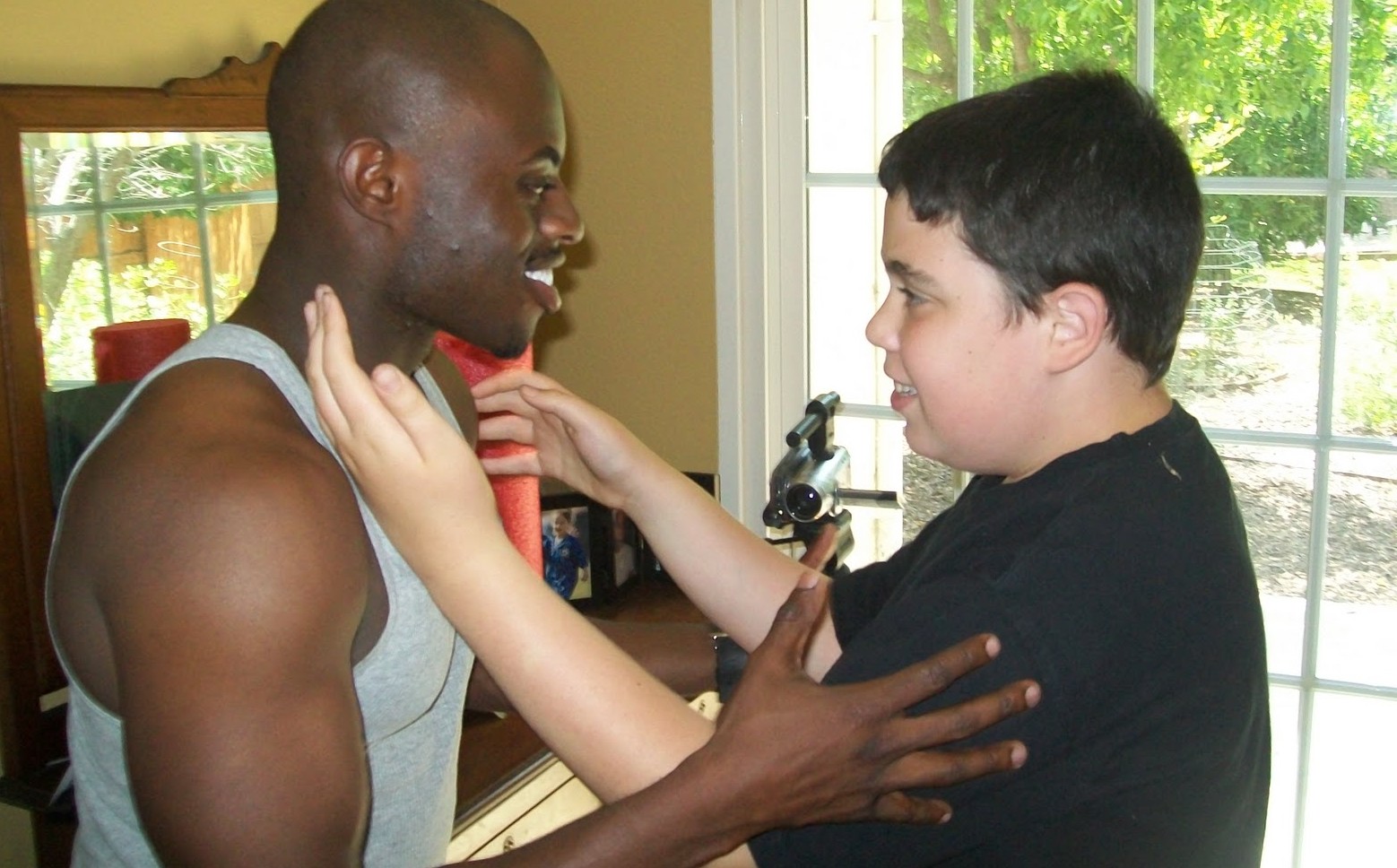by Mary W Maxwell
One of my first articles at Gumshoe News was about a 17-year-old intellectual, Ido Kedar, who had written a fascinating account of his autism, especially in regard to motor deficiency. The title of his book is “Ido in Autismland.” Now age 19 he runs a website by that same name, in which he very protectively gives advice to children afflicted with severe autism, especially ones who can’t talk.
Ido (pronounced ee-doh) is vehemently opposed to the ABA method that was his lot for many years — a kind of behavior mod that assumes the autistic child is bereft of brains. Today Ido’s website published a piece on physical exercise, which I print in full here, with his permission:
Exercise as an Early Intervention
by Ido Kedar, at idoinautismland.com:
I believe exercise is one of the most important early interventions for autism. In so many cases I see people with autism who barely walk ten feet and have no muscle tone, yet no one works on fitness with them. In a mind/body communication disconnect, early exercise programs can help forge a better communication network between body and brain.
I’m sure the kid gym classes I took as a toddler and a young boy helped me be more coordinated, though I wish I had had more intensive help in several areas I will discuss. If I had received that support when I was younger I would have an easier time now in fitness.
In no particular order I recommend early intervention in:
- stretching,
- coordination–especially bilateral movements
- cardio work, such as hiking and running
- strength training.
My biggest motor obstacle today is that I have tight muscles and tendons. It is a problem affecting my physical comfort and will take a lot of time and effort to improve. I feel that it should have been noticed by adaptive PE teachers, or occupational therapists, or other professionals working with me physically, but they never said a word.
Physical assessments looking at the areas I mentioned should be standard because catching problems early makes them easier to fix.
Since professionals may miss things, parents should be vigilant and try to work on stretching, cardio, strength and coordination with their kids starting when they are young and making it part of their lifestyle.
Going for brisk walks, doing simple stretches, picking up light weights, or touching alternate toes, are all things young children can do daily and can help make movement and exercise comfortable and can help the body learn to listen better to the brain.
— end of Kedar’s item
I [Maxwell] replied to Ido that I was lucky, a few days ago, to have purchased, at Brisbane airport, the latest book by Norman Doidge, MD: “The Brain’s Way of Healing” about neuroplasticity. Here is a quote about a 5-month-old baby who had developed meningitis (from a bacterial infection picked up in a neonatal intensive care unit):
“When Sydney was first brought to Baniel’s Center at five months he was completely spastic. He couldn’t roll over. As with many people with strokes, his fists were tightly contracted and his arm was bent up against his chest, completely immovable. His parents were told he’d never walk. But at the end of his first session he opened both of his hands. He made progress with each visit, eventually learning to roll over and back. Baniel told his parents, “The same brain that learned to roll over, and sit up, is going to talk.” (Doidge 2015: 194)
Note: Doidge has already had a bestseller “The Brain That Changes Itself.” On the back cover of the new book Doidge says:
“We have seen symptoms of multiple sclerosis, Parkinson’s disease, brain injuries, and cerebral palsy radically diminish…without surgery or medication.”
The Unique Work of Teresa Conrick
Teresa Conrick is the mother of 21-year-old, Megan, a beautiful, redhead daughter – who has severe regressive autism (that is to say, it began at age 18 months after the MMR and hib vaccines). The Mom has been looking into the microscopy of that illness, with special interest in the significance of the biome.
It’s very weird that Science Leaders are not jumping up and down over the fact the Human Genome Project’s mapping caused us to discover that much of the DNA in the human body is in fact bacterial DNA.
In any case, just as I was finishing this article about Ido and exercise, I hopped over to the Age Of Autism website and found that coincidentally Ms Conrick has also been looking at connections between Parkinson’s and autism. She writes:
[Megan’s] regression into Autism before her 3rd birthday was torture, with horrible GI issues, chronic infections and total loss of both receptive and expressive language. Here we are in 2015 and the connections of both Parkinson’s and Autism are becoming more and more intriguing:
- Study finds high rate of Parkinson’s disease among adults with autism:
- In the first part of the study, the investigators found high rates of Parkinson’s motor signs (trembling, rigidity, instability, etc.) in a broad investigation of health issues among 19 adults with autism in their fifties and older….(20 percent) received a diagnosis of Parkinson’s disease. By contrast, Parkinson’s affects less than one tenth of one percent of the general population over age 60.
- Overall, the main finding from the studyis that adults with autism may have substantially elevated risk for Parkinson’s disease…. this observation [may have] important implications for understanding the neurobiology of autism and treatment of manifestations in older adults.
Connections to the gut and the Microbiome make this pertinent. Many children, like my daughter, Megan, began their descent into the symptoms of Autism with GI issues, usually constipation:
Coincidentally, constipation is a hallmark symptom of Parkinson’s. Heartbreaking to see that Parkinson’s patients usually begin their regression with GI issues as well, but it is a big clue. Not too long ago, I reported that the Michael J. Fox Foundation has been doing some brilliant research. [related to the biome]:
- Children with autism appear to have distinctly different levels of intestinal flora, which may increase their vulnerability to pathogenic bacteria and perhaps play a role in autism pathogenesis “Most notably, we also discovered that the genera Prevotella, Coprococcus, and unclassified Veillonellaceae were significantly reduced in autistic children”
- . [Also] we explore the possibility that gut–brain interactions could also be a direct result of microbially produced metabolites.
Here is related research in Parkinson’s:
“Intestines as a Window to the Brain”
“There is a clear effect of Parkinson’s disease on the gastrointestinal system. Nearly 80 percent of people with PD have constipation, and this condition often predates the motor symptoms of Parkinson’s by several years.”
“Additionally, alpha-synuclein — a protein that clumps in the brains of all people with Parkinson’s — has been found in several locations outside the brain, including the nerves controlling the intestines.”
“Lastly, researchers believe the normal bacteria of the gut might affect the functioning of the gut nerves which could in turn affect the nerves of the brain.”
Teresa Conrick continues with further information from the Michael Fox Foundation in her October 27, 2015 article at Age of Autism. She says: The Microbiome is truly turning out to be our window to the brain and hopefully, we can use the technology of today to change the future.”
— Mary Maxwell lives in Adelaide. She hopes for visitors at her website, maryWmaxwell.com

































Correction: Megan is 22, not 21. I have just recalled the Mother mentioning that as of the 22nd birthday “the school bus won’t come anymore” and funding for helpers ceases.
Imagine it.
Very annoying. I paid 35 AUD for Doidge but I see Amazon has it for 13 USD. I see it got 288 reviews, and it leads to another book: The Brain Maker about gut-and-brain, which has 488 reviews. So I went to see how my book is doing on reviews (Fraud Upon the Court). None, as usual. Still, the search led me to some new items of actual fraud-upon-the-court. More on that later!
Parkinsons – is that similar to Guillain-Barrè syndrome?
G-B is an autoimmune condition – a form of nerve inflammation resulting in a spreading paralysis.
Well Sherri Tenpenny has just reported on vaccine court settlements – with the flu shot being a culprit.
Any similarity?
http://theflushotsite.com/index.php/2015/10/27/flu-vaccine-now-most-dangerous-vaccine-according-to-documents/?utm_source=CCNewsletter&utm_medium=Email&utm_campaign=FluVaxxMostDangerous
GBS can be as simple as a post-viral illness consequence (immune response…just like a vaccine gives). That’s how we used to see it present…after viral illnesses. Its proving treatable in its early stages these days through plasmapharesis, but every so often we would still see one slip through that progressed to complete paralysis (with locked-in syndrome) in a remarkably short time. Twelve months to recovery (or partial recovery) when its that severe.
And don’t forget Mary Maxwell’s Open Letter to the Privy Council re vaccination.
http://gumshoenews.com/2015/06/02/an-open-letter-to-the-privy-council
I’m curious why more isn’t being said about recent revelations that the herbal pesticide, glyphosate, made by Monsanto, is a likely culprit in triggering Autism (see link below). The fact that this isn’t a huge newsflash being discussed around the world – or at least on the relevant Autism, websites, etc, – makes me think I’m missing something. Especially as I read posts like the above, where the discussion is centered on gut flora as it relates to Parkinsons, Autism, etc. Granted, it may not be the final, conclusive, decisive smoking gun (although it also just might be), but it sure seems pretty damn compelling to me (the casual, layperson-bystander, btw). Just curious as to any thoughts….
http://www.globalresearch.ca/monsanto-glyphosate-roundup-herbicide-triggers-autism-in-children-mit-scientist/5433023